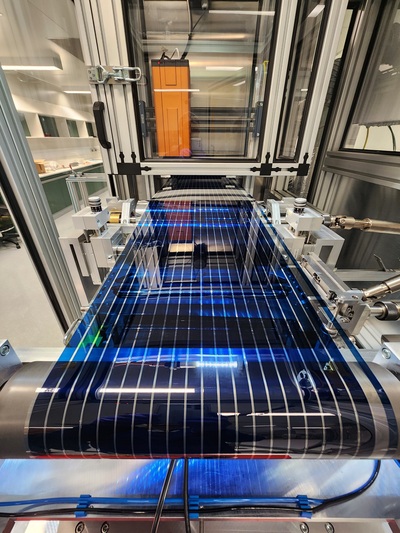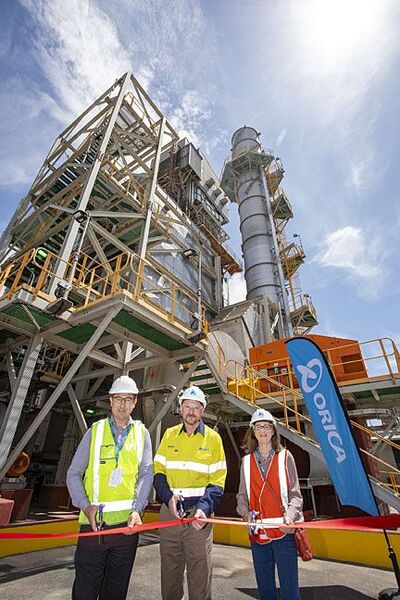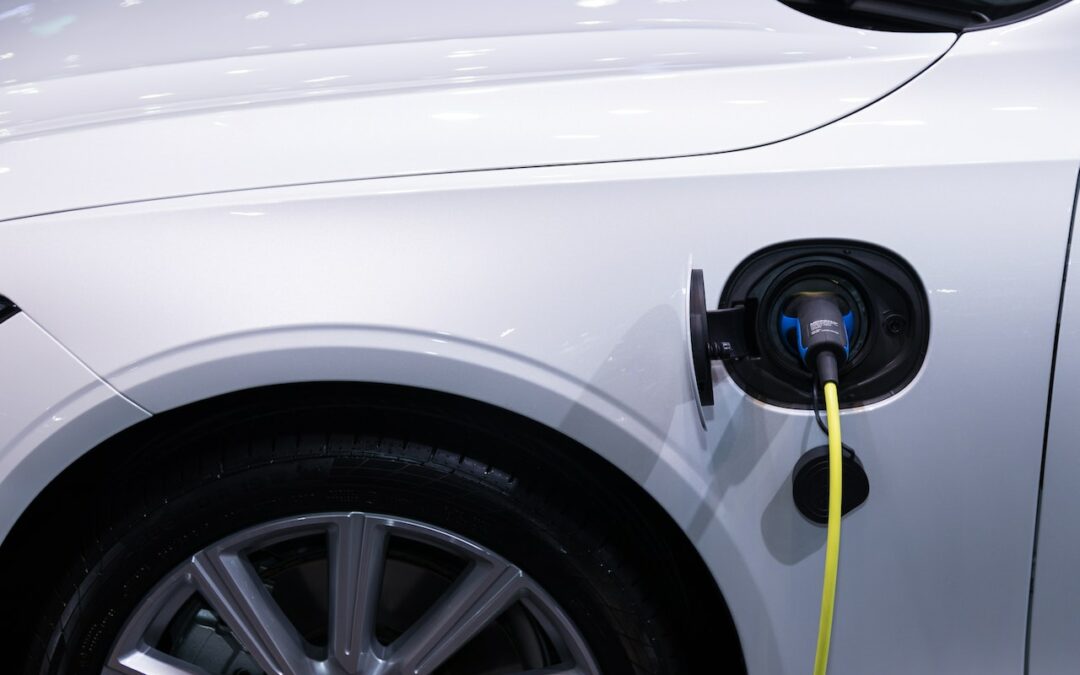
by Komoneed | Nov 5, 2024
CSIRO has opened its $6.8 million facility in Clayton, Victoria, dedicated to taking its printed flexible solar technology out of the lab and into the real world to help meet the growing demand for renewable energy across sectors.
Unlike traditional silicon solar panels, CSIRO’s flexible solar cells are printed on thin plastic films. This makes them lightweight, portable and suitable for various applications across urban construction, space, defence, mining, emergency management, disaster relief and wearables.
The leader of CSIRO’s Renewable Energy Systems Group, Dr Anthony Chesman, said printed flexible solar is not intended to replace silicon rooftop panels, but rather to complement them.
“This printed solar technology unlocks entirely new applications for affordable, versatile and sustainable energy generation,” Chesman said.
Professor Elanor Huntington, CSIRO’s Executive Director, Digital, National Facilities and Collections, added: “Through CSIRO’s new Printed PV Facility, industry partners can access both researcher expertise and specialised equipment to improve and apply flexible solar technology in novel ways, anywhere there is sunlight.
“This not only offers incredible opportunities for Australian manufacturers but also contributes to addressing global energy challenges and advancing the transition to net zero.”
CSIRO’s solar cells are made using an advanced material called perovskite, which is printed on long continuous rolls of flexible film.
“Our new system is highly automated. The multiple printing and laminating steps are performed in a single continuous operation, which significantly cuts down on production costs and the upfront investment needed to get started,” Chesman said.
“Our team has also developed an automated system that can produce as many as 14,000 test solar cells a day to fine-tune their design and performance.
“We’re looking for partners who want to join us on the R&D journey and ultimately take this technology to market.
“Our industry partners will gain access to both our cutting-edge equipment and our team of world-class scientists with their deep expertise in solar technology.”
In addition to printed flexible solar, the lab is equipped to explore other fields that use printable materials for battery and hydrogen technologies, opening doors to a wider range of innovative applications.
Earlier this year, CSIRO set a new efficiency record for its flexible solar technology.
The Printed PV Facility received funding from Australian Renewable Energy Agency (ARENA) via the Australian Centre for Advanced Photovoltaics (ACAP).

by Komoneed | Nov 5, 2024
Orica has announced the completion of an environmental improvement project to reduce emissions of ammonium nitrate (AN) particulate from its Kooragang Island manufacturing site in the Hunter Valley.
The project has involved retrofitting the prill tower1 with an irrigated fibre-bed scrubber2 to capture particles of AN produced during the manufacturing process.
The abatement technology is designed to reduce AN particulate emissions, including fine particles with a diameter of 2.5 µm or less, by approximately 95%. The captured emissions are then recirculated in the manufacturing process to produce critical products for the resources and medical industries across Australia.
Orica President – Australia Pacific and Sustainability Germán Morales said the project is designed to ensure the sustainability of the Kooragang Island site.
“We understand and share the community’s desire for better air quality in general, and we are proud to play a role in achieving this,” Morales said.
“From start to finish, we have worked closely with the NSW Environment Protection Authority to ensure the project meets regulatory expectations and delivers optimal outcomes for the community and the environment.”
Designing, fabricating and installing the scrubber was a multi-year, large-scale and complex engineering project, with the construction phase alone taking more than 18 months or 115,000 work hours to complete.
“Retrofitting the scrubber to an existing and operating prill tower which stands at around 52 metres high has been technically challenging,” Morales said.
“Completing this project is a great achievement for the site and a real testament to the expertise of our people.”
1. The prill tower is where liquid ammonium nitrate is turned into small, solid ammonium nitrate balls (prill).
2. An irrigated fibre-bed scrubber is designed to clean the contaminants out of a gas stream. The first stage removes large particles via woven stainless steel mesh pads. The second stage removes fine particles via what are known as Brink filters. These filters are woven tubes that accumulate and coalesce the finer particulates into solution for collection in a sump at the bottom of the scrubber.

by Komoneed | Nov 2, 2024
At least 158 people have died in the “deadliest episode of flooding in Spain’s modern history,” reported The Guardian. Many more are still missing. The storm that started on Tuesday in southern and eastern Spain brought a year’s worth of rainfall in hours, CNN reported. In the hardest-hit Valencia region, where most of the deaths […]
The post Spain Flooding Death Toll Climbs to 158 as Severe Weather Continues appeared first on EcoWatch.

by Komoneed | Nov 2, 2024
October 2024 Newsletter Recap: Just Energy Transition
jschoshinski
Thu, 10/31/2024 – 20:38
Did you miss the Climatelinks October newsletter? We’ve got you covered. Please find a recap of the October ‘Just Energy Transition’ theme below. You won’t want to miss this short list of top resources and blogs from the month. Subscribe to our newsletter today. Do you want to contribute to the Climatelinks community? Send us a resource, blog, or event.
Inclusive, gender-equitable, and participatory decision making are essential for a just energy transition. This includes assisting people, industries, employees, and countries to foster a just transition to climate-resilient livelihoods and employment. USAID programs and initiatives are helping the global economy transition to become low-carbon and resilient while producing positive environmental, social, and economic outcomes.
Fresh Blog Posts
Advancing Equity for Women and Underrepresented Groups in Energy and Transportation
When women are incorporated into transportation planning, systems are often safer, more affordable, and more efficient, with better routes and greater workforce opportunities. Similarly, when a diverse range of affected community members can give input on energy projects, outcomes improve and are more sustainable. The USAID-National Renewable Energy Laboratory Partnership recognizes this and is working to increase gender integration and participation from underrepresented groups.
Filling the Gap: A Framework for Ensuring a Just Energy Transition for Coal Communities
To date, just transition practices have often come from isolated, grassroots initiatives with limited guidance from past efforts, such as “best practice” resources or frameworks for success. A new resource from USAID, Arizona State University, and the United States Energy Association attempts to fill this gap by outlining key principles of a just transition and best practices to enhance outcomes of investments in decarbonization, specifically for coal workers and communities.
Editor’s Pick: Just Energy Transition Blogs
Advancing a just transition to a low-carbon economy is an important aspect of USAID’s 2022-2030 Climate Strategy. This roundup highlights blogs that showcase how USAID is catalyzing a just energy transition by supporting inclusive workplace policies, reducing air pollution, and more.
New Resources
Just Energy Transition for Coal Communities: An Actionable Community-Based Framework
As decarbonization accelerates, this report seeks to lay out some guidance and best practices for facilitating a just energy transition, specifically for coal workers and communities. The action-based just transition framework consists of three stages: making the transition decision, identifying and engaging all stakeholders and planning the transition, and executing the transition and offering assistance during and after coal is phased out.
Just and Sustainable Mobility Transition in the Transport Sector: A Conceptual Framework and Gender Mainstreaming Case Studies
The rapid global shift towards low-carbon transport creates the opportunity to reimagine the world’s transport systems through a holistic and sustainable approach, shifting to low- and zero-carbon modes and offering wider access. This report from the USAID-National Renewable Energy Laboratory Partnership proposes a conceptual framework that may, in the long term, enable just and sustainable mobility transitions in the transport sector.
Tanzania Sustainable Landscapes Opportunity Analysis: Desk Review
This Sustainable Landscapes Opportunity Analysis, commissioned by USAID, provides an overview of options to reduce greenhouse gas emissions from land-based conservation, management, and restoration in Tanzania. Based on a review of peer-reviewed literature, articles, and reports, this analysis identifies several land-based climate mitigation options with the potential to mitigate the effects of climate change while providing benefits for people and nature.
Nature-Based Solutions for Agricultural Resilience Factsheet
Under the Nature-Based Solutions for Agricultural Resilience Window, the USAID Climate Finance for Development Accelerator (CFDA) will partner with the private sector to pilot or scale innovative models for financing both sustainable agriculture and biodiversity conservation in the countries where USAID works. CFDA anticipates issuing three or more grant awards at $500,000 each.
Climate Risk Management Spotlight
Evaluation of Climate Risk Management at USAID
This report presents results from the performance evaluation of climate risk management (CRM) at USAID. The evaluation employed a mixed-methods approach including a document review, an online survey of USAID staff, key informant interviews with USAID staff and implementing partners, group interviews with activity beneficiaries, and four country case studies. The evaluation found that CRM integration into the program cycle should be viewed as a longer-term process of institutional change.
Call for Content
Share your events and resources or write a blog related to an upcoming monthly theme! Check out our upcoming themes to see if your climate work aligns:
November: COP29—we’re especially looking for implementation stories about USAID initiatives announced at previous COPs!
2024 Cross-cutting Themes: Systems Change and Locally Led Development
If your USAID-related climate change work relates to these themes, Climatelinks would love to feature your work and share your resources. Send us a resource or blog.
Teaser Text
Did you miss the Climatelinks October newsletter? Please find a recap of the October ‘Just Energy Transition’ theme.
Publish Date
Thu, 10/31/2024 – 12:00
Author(s)
Climatelinks
Hero Image
IMG_4816.JPG
Blog Type
Newsletter Recap
Strategic Objective
Integration
Mitigation
Region
Global
Topic
Agriculture
Emissions
Climate/Environmental Justice
Climate Risk Management
Climate Strategy
Inclusive Development
Energy
Clean or Renewable Energy
Gender and Social Inclusion
Green Jobs
Transportation
Sustainable Land Management
Nature-based Solutions
Natural Climate Solutions
Country
Tanzania
Sectors
Energy
Show Download Link
On

by Komoneed | Nov 2, 2024
We can expect Ford’s mid-size electric pickup to launch in the next few years





